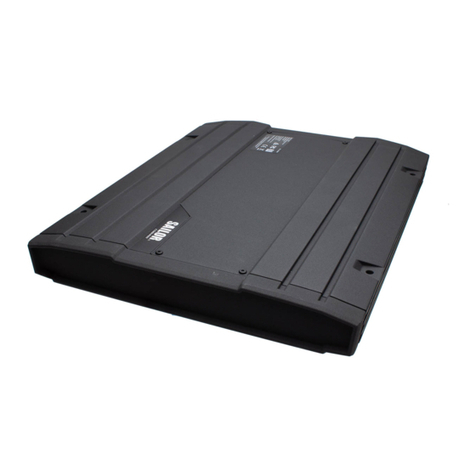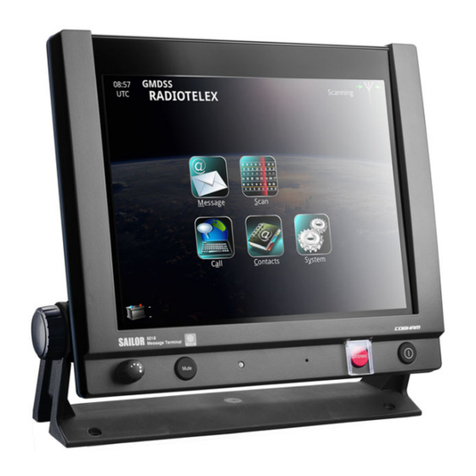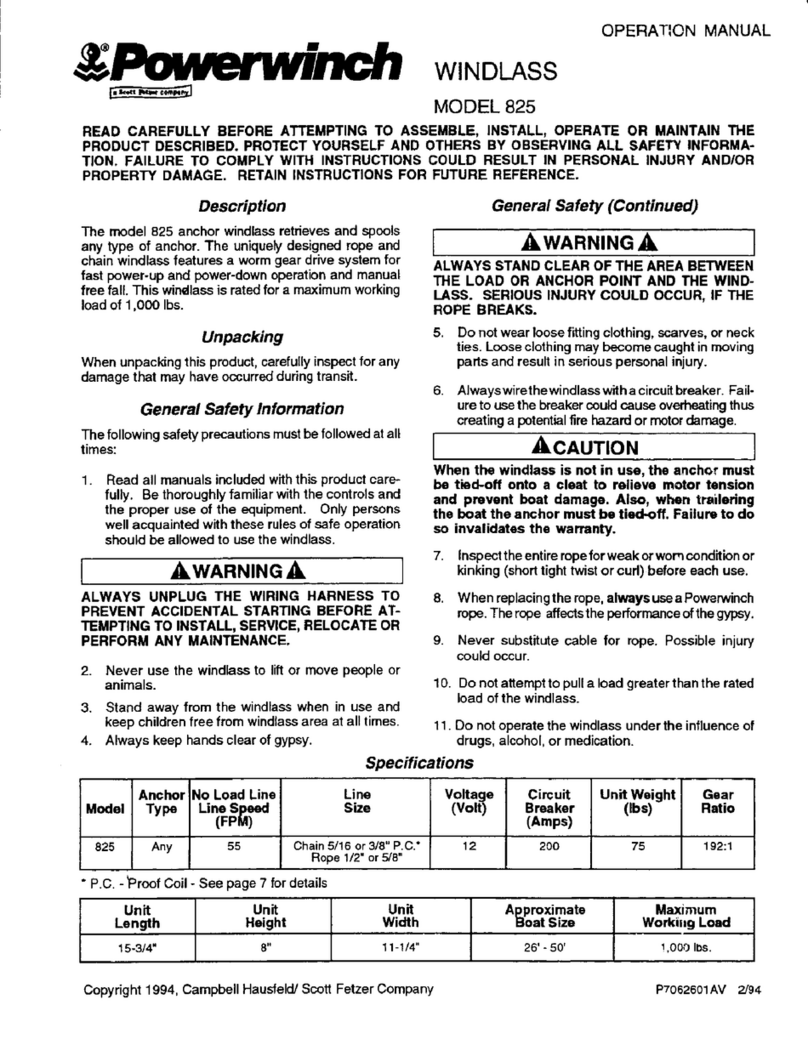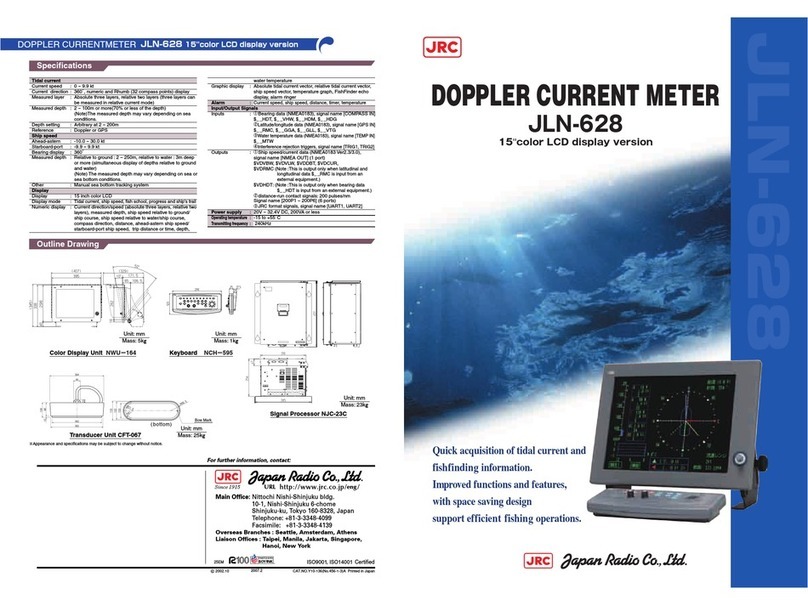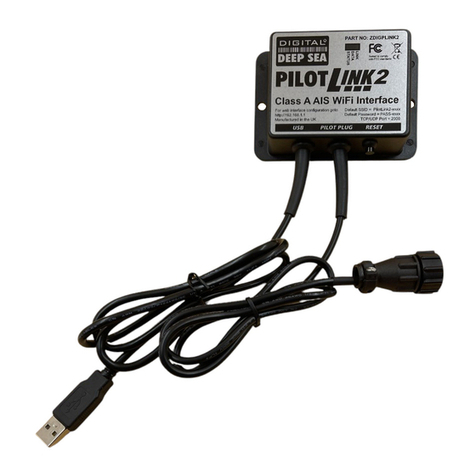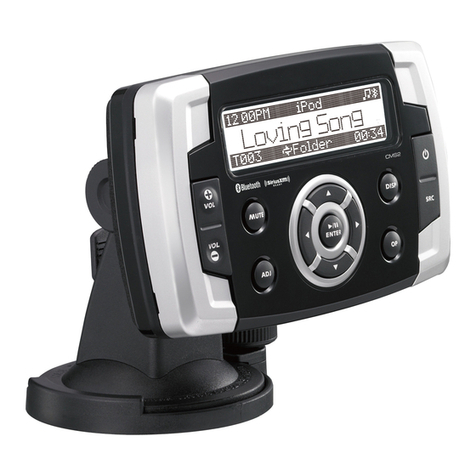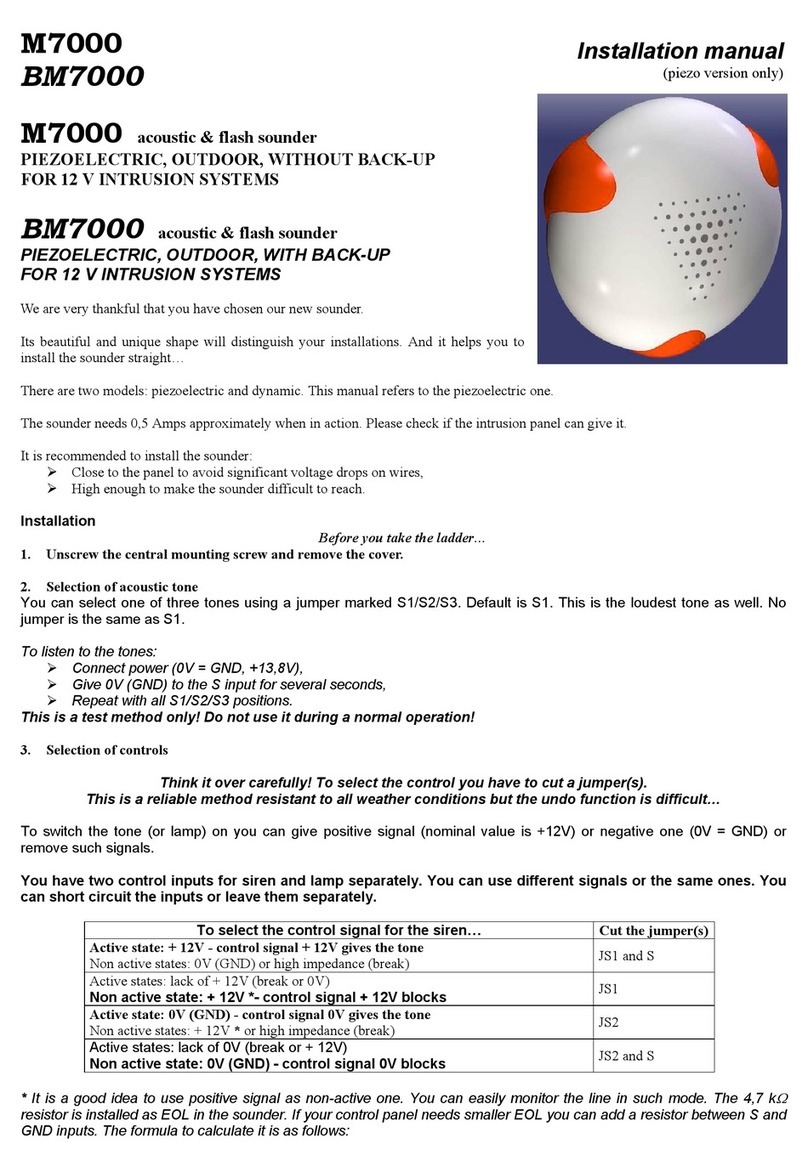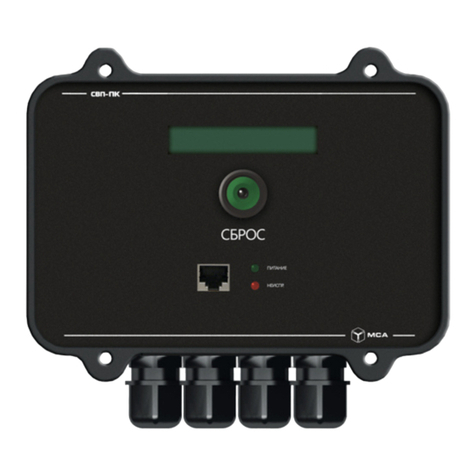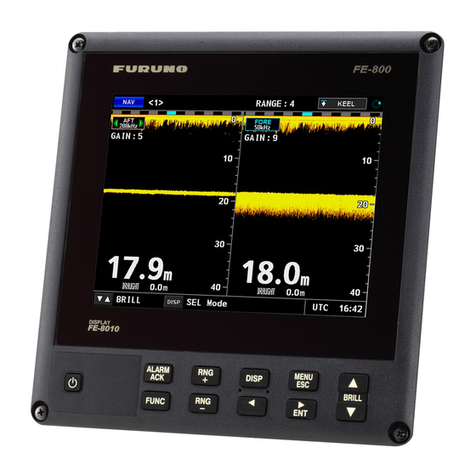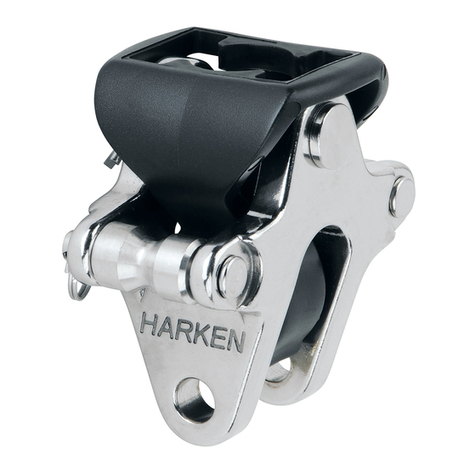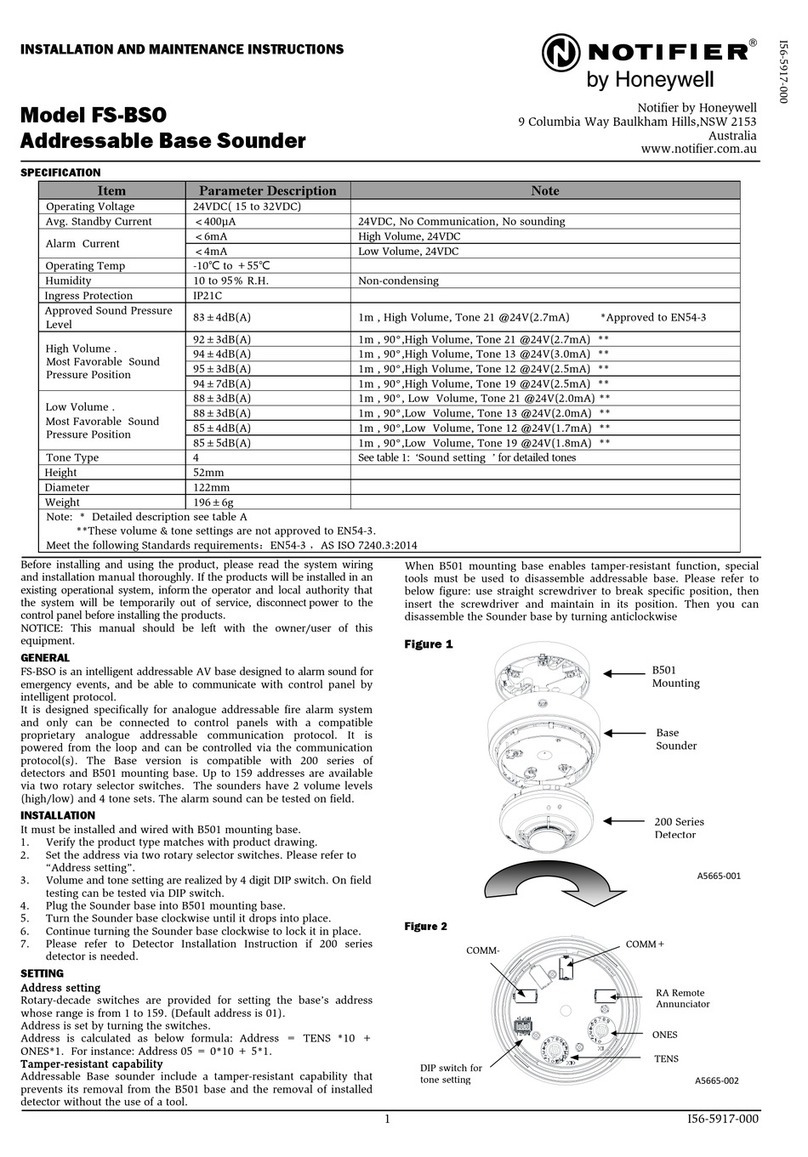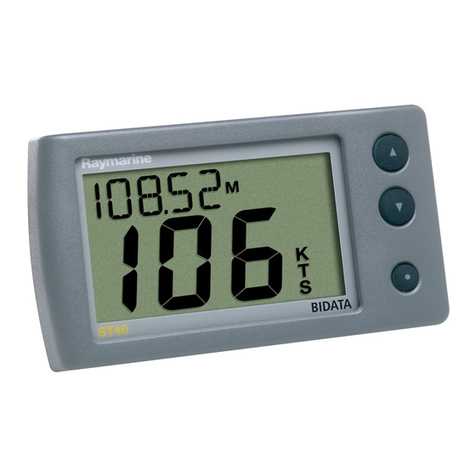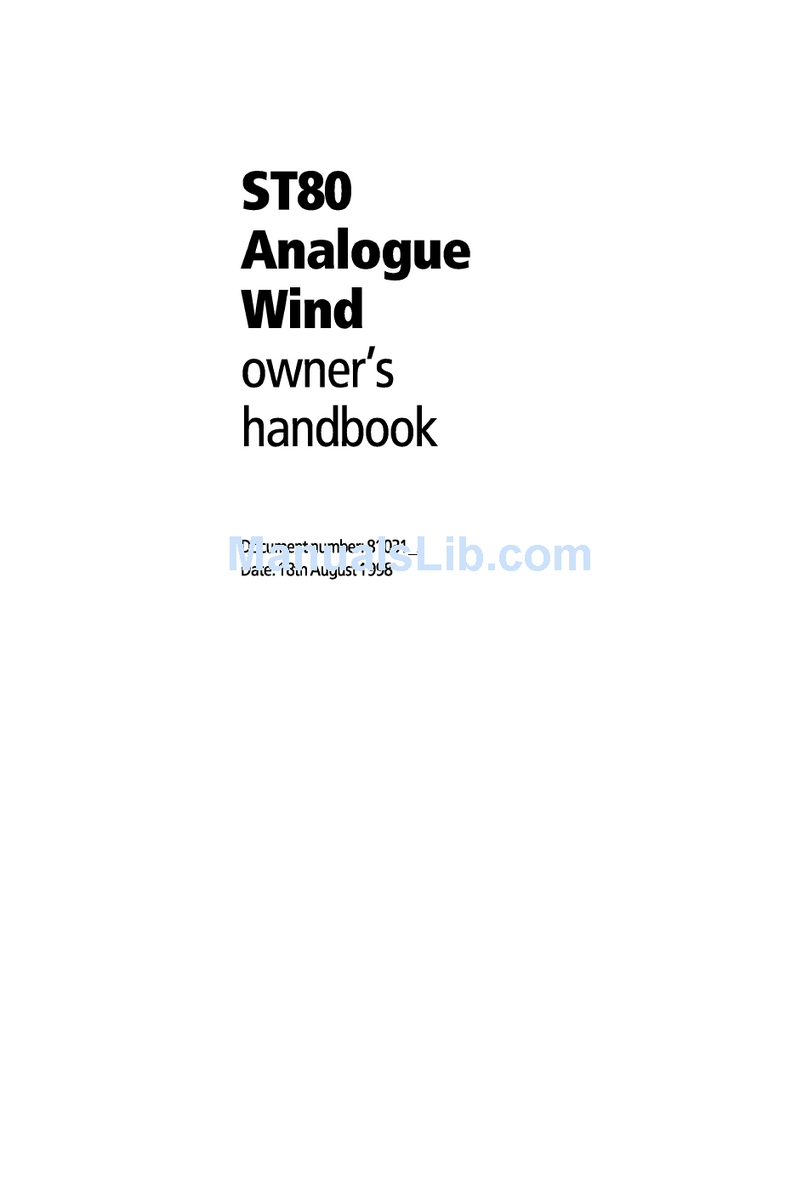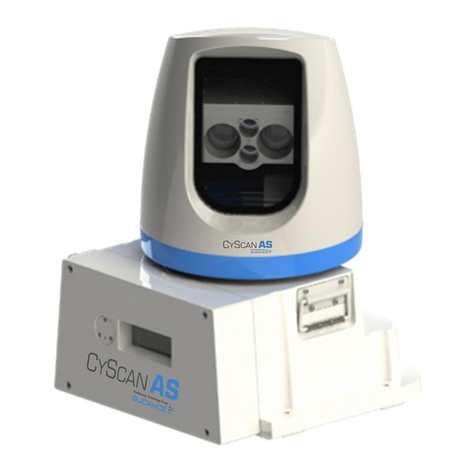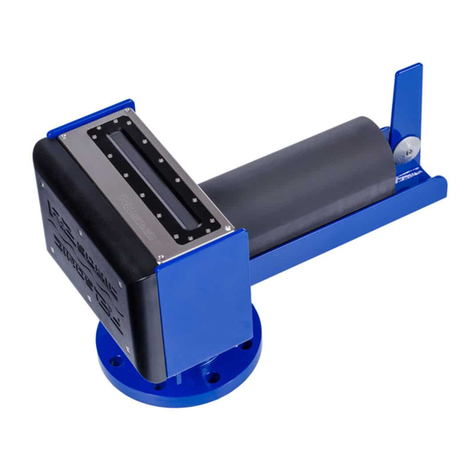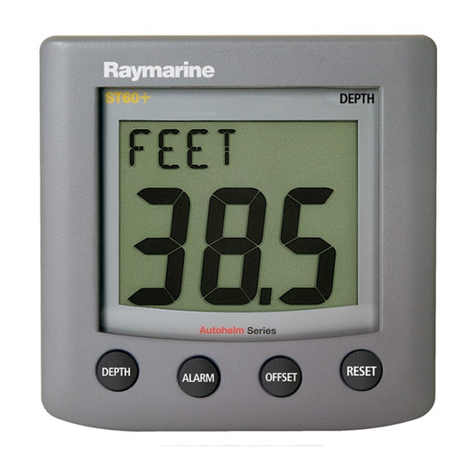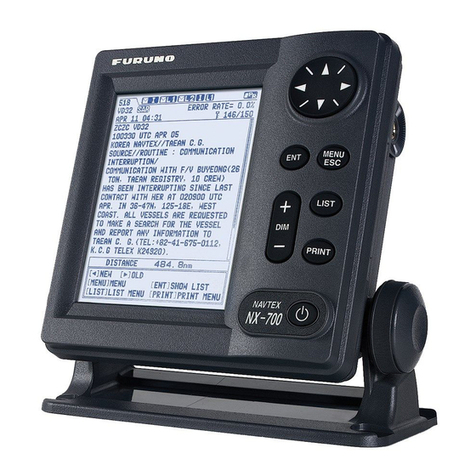COBHAM SAILOR 6282 User manual

SAILOR 6282 AIS Transponder
SAILOR 6280/6281 AIS System
User manual


i
SAILOR 6282 AIS Transponder
SAILOR 6280/6281 AIS System
User Manual
Document number: 98-135323-H
Release date: February 24, 2022

ii 98-135323-H
Disclaimer
Any responsibility or liability for loss or damage in connection with the use of
this product and the accompanying documentation is disclaimed by Thrane
& Thrane A/S. The information in this manual is provided for information
purposes only, is subject to change without notice and may contain errors or
inaccuracies. Manuals issued by Thrane & Thrane A/S are periodically revised
and updated. Anyone relying on this information should acquire the most
current version e.g. from www.cobhamsatcom.com, Cobham SYNC
Partner Portal, or from the distributor.Thrane & Thrane A/S is not
responsible for the content or accuracy of any translations or reproductions,
in whole or in part, of this manual from any other source. In the event of any
discrepancies, the English version shall be the governing text.
Thrane & Thrane A/S is trading as Cobham SATCOM.
Copyright
© 2022 Thrane & Thrane A/S. All rights reserved.
Trademark Acknowledgments
• SAILOR is a registered trademark of Thrane & Thrane A/S in the European
Union and the Unites States of America and other countries.
• Other product and company names mentioned in this manual may be
trademarks or trade names of their respective owners.
• This product contains Android™ software. Android is a trademark of
Google Inc.

98-135323-H iii
GPL notification
The software included in this product contains copyrighted software that is
licensed under the GPL/LGPL. The verbatim licenses can be found online at:
http://www.gnu.org/licenses/old-licenses/gpl-2.0.html
http://www.gnu.org/licenses/old-licenses/lgpl-2.1.html
For the parts of the software that fall under the GPL/LGPL licenses, you may
obtain the complete corresponding source code from us for a period of three
years after our last shipment of this product, which will be no earlier than 31.
December 2027, by sending a money order or check for DKK 50 to:
SW Technology/GPL Compliance,
Cobham SATCOM (Thrane & Thrane A/S),
Lundtoftegaardsvej 93D
2800 Lyngby
DENMARK
Write "source for product SAILOR 6282 AIS Transponder" in the memo line of
your payment. This offer is valid to anyone in receipt of this information.
https://www.cobhamsatcom.com/legal/free-and-open-source-software-foss/

iv 98-135323-H
Safety summary
Observe the following general safety precautions during all phases of
operation, service and repair of this equipment. Failure to comply with these
precautions or with specific warnings elsewhere in this manual violates safety
standards of design, manufacture and intended use of the equipment. Thrane
& Thrane A/S assumes no liability for the customer's failure to comply with
these requirements.
Ground the equipment
To minimise shock hazard, connect the SAILOR 6282 AIS Transponder to an
electrical ground and follow the cable instructions.
RF exposure hazards and instructions
The SAILOR unit generates electromagnetic RF energy when transmitting. To
ensure that you and those around you are not exposed to excessive amounts
of energy and to avoid health hazards from excessive exposure to RF energy,
all persons must be at least 0.2 m away from the antenna when the unit is
transmitting.
Warranty limitation
IMPORTANT - The SAILOR 6285 GPS Antenna – Active is a sealed waterproof
unit (classified IPx6 & IPx8). To create and maintain its waterproof integrity it
was assembled in a controlled environment using special equipment. The
SAILOR 6282 AIS Transponder is not a user maintainable unit, and under no
circumstances should the unit be opened except by authorized personnel.
Unauthorized opening of the unit will invalidate the warranty.
Installation and service
Installation and general service must be done by skilled service personnel.
Compass safe distance
Compass safe distance: 55 cm (Standard magnetic compass), 45 cm
(Emergency magnetic compass) from the SAILOR 6282 AIS Transponder or
the SAILOR 6283 AIS Connection Box and Wall Tray.

98-135323-H v
Preface
Approvals
The SAILOR 6282 AIS Transponder obeys the requirements of the Marine
Equipment Directive 2014/90/EU and is intended for use in maritime
environment.
The SAILOR 6282 AIS Transponder is approved to MED 2014/90/EU and obeys
the requirements in the standards: IEC 61993-2 (2018), IEC 60945 (2002) incl.
IEC 60945 Corr. 1 (2008), ITU-R M.1371-5 (2014), IEC 61162-1 (2016), IEC
61162-2 ed1.0 (1998-09).
The SAILOR 6282 AIS Transponder is approved to FCC CFR47 part 80 with USCG
approval no. 165.155/EC0168/BABT-MED000046/0575.
The SAILOR 6282 AIS Transponder is approved for Inland AIS according to
CCNR VTT Standard Ed. 1.2 and Inland AIS Test standard De 2.0.
The SAILOR 6282 AIS Transponder is approved to IC and obeys the
requirements in RSS-182.
The SAILOR 6282 AIS Transponder is approved to be a BAM compliant Maritime
navigation and radio communication equipment and obeys the requirements in
the standards IEC-62923-1 (2018) and IEC-62923-2 (2018).
The approvals of the SAILOR 6282 AIS Transponder are constantly monitored.
New national approvals will be applied for and granted and new test standards
may come into force. Therefore the above list may not be complete. Contact
your authorized dealer for more information.
Training information
The SAILOR 6282 AIS Transponder is designed for occupational use only and is
also classified as such. It must only be used in the course of employment by
individuals aware of the hazards as well as the way to minimize those hazards.
The unit is thus NOT intended for use in an uncontrolled environment by general
public. The SAILOR 6282 AIS Transponder has been tested and complies with the
FCC RF exposure limits for Occupational Use Only. The unit also complies with
the following guidelines and standards regarding RF energy and electromagnetic
energy levels including the recommended levels for human exposure:
• FCC OET Bulletin 65 Supplement C, evaluating compliance with FCC
guidelines for human exposure to radio frequency electromagnetic fields.

vi 98-135323-H
• American National Standards Institute (C95.1) IEEE standard for safety
levels with respect to human exposure to radio frequency
electromagnetic fields, 3 kHz to 300 GHz.
• American National Standards Institute (C95.3) IEEE recommended
practice for the measurement of potentially hazardous electromagnetic
fields - RF and microwaves.
Below is a description of the RF exposure hazards and instructions in safe
operation of the unit within the FCC RF exposure limits established for it.
Warning
Your SAILOR unit generates electromagnetic RF (radio frequency) energy
when it is transmitting. To ensure that you and those around you are not
exposed to excessive amounts of that energy (beyond FCC allowable limits
for occupational use) and thus to avoid health hazards from excessive
exposure to RF energy, FCC OET bulletin 65 establishes a Maximum
Permissible Exposure (MPE) radius of 0.2 m for the maximum power of your
unit (12.5 W selected) with a half wave omni-directional antenna having a
maximum gain of 3 dB (5.2 dBi). This means all persons must be at least 0.2 m
away from the antenna when the unit is transmitting.
Alerte de Sécurité
Dangers liés á l'exposition aux fréquences radio et instructions.
Conformément á la réglementation d'industrie Canada, le present radio
emetteur ne peut fonctionner qu'avec une antenne de type
omnidirectionelle, demi-onde ou d'un gain maximale de 3 dB, approuvée par
Industrie Canada. Pour éviter les risques pour la santé dûs á une exposition
excessive aux champs de fréquences radio, une distance minimale de 0.2 m
est nécessaire entre l'utilisateur et le radio-émetteur.
Installation
The SAILOR 6282 AIS Transponder is designed for installation by a skilled
service person.
1. An omni-directional antenna with a maximum power gain of 5.2 dBi must
be mounted at least 2.2 m above the highest deck where people may be
staying during radio transmissions. The distance is to be measured
vertically from the lowest point of the antenna. This provides the
minimum separation distance which is in compliance with RF exposure
requirements and is based on the MPE radius of 0.2 m plus the 2 m height
of an adult.

98-135323-H vii
2. On vessels that cannot fulfill requirements in item 1, the antenna must be
mounted so that its lowest point is at least 0.2 m vertically above the heads
of people on deck and all persons must be outside the 0.2 m MPE radius
during radio transmission.
• Always mount the antenna at least 0.2 m from possible human access.
• Never touch the antenna when transmitting
• Use only authorized SAILOR accessories.
3. If the antenna has to be placed in public areas or near people with no
awareness of the radio transmission, the antenna must be placed at a
distance not less than 1.8 m from possible human access.
Failure to observe any of these warnings may cause you or other people to
exceed FCC RF exposure limits or create other dangerous conditions.
About the manual
Intended readers
This manual is a user manual for the SAILOR 6282 AIS Transponder system. This
manual is intended for anyone who is using or intends to use this system. No
specific skills are required to operate the SAILOR 6282 AIS Transponder.
However, it is important that you observe all safety requirements listed in the
beginning of this manual, and operate the system according to the guidelines in
this manual.
Note that this manual does not cover installation of the system. For information
on installation refer to the installation manual. Part numbers for related manuals
are listed in the next section.

viii 98-135323-H
Related documents
The following table shows the documents related to this manual and to the
SAILOR 6282 AIS Transponder.
Typography
In this manual, typography is used as indicated below:
Bold is used for the following purposes:
• To emphasize words.
Example: “Do not touch the antenna”.
• To indicate what the user should select in the user interface.
Example: “Select SETTINGS > LAN”.
Italic is used to emphasize the paragraph title in cross-references.
Example: “For further information, see Connecting Cables on page...”.
Title and description Document
number
SAILOR 6280/6281 AIS System,
Installation manual
98-137573
SAILOR 6004 Control Panel,
Installation manual
98-136644
SAILOR 6282 AIS Transponder,
Installation guide
98-136017
SAILOR 6283 AIS Connection Box and Wall
Tray, Installation guide
98-136018
SAILOR 6285 GNSS Antenna - Active,
Installation guide
98-136019

98-135323-H ix
Table of contents
Chapter 1 Introduction
Introduction to AIS .....................................................................................................1
The SAILOR 6280/6281 AIS System .............................................................. 4
System components .................................................................................................. 6
Chapter 2 Operation
To get started ..................................................................................................................9
Settings ............................................................................................................................. 15
To work with messages ......................................................................................... 34
Alerts and notifications ......................................................................................... 42
Chapter 3 Service & maintenance
Maintenance ................................................................................................................. 51
Troubleshooting guide ........................................................................................... 57
Service and repair ...................................................................................................... 59
Appendix A Specifications
SAILOR 6282 AIS Transponder ....................................................................... 63
SAILOR 6285 GNSS Antenna - Active ......................................................... 66
SAILOR 6004 Control Panel ............................................................................... 67
SAILOR 6283 AIS Connection Box and Wall Tray .............................. 68
Appendix B NMEA sentences
Sentences defined in IEC 61162-1 ............................................................... 69
Sentences defined by Cobham SATCOM ................................................. 69
Glossary ................................................................................................................................................. 71
Index ................................................................................................................................................. 75

Table of contents
x 98-135323-H

98-135323-H 1
Chapter 1
Introduction 1
This chapter introduces the SAILOR 6282 AIS Transponder and gives an
overview of the system and services. It has the following sections:
•Introduction to AIS
•The SAILOR 6280/6281 AIS System
•System components
Introduction to AIS
Overview
AIS (Automatic Identification System) is a communication system for the
exchange of navigation data. An AIS station can be a ship station or a shore-side
base station. AIS stations operate without interaction by ship or shore personnel
(autonomous and continuous). AIS has evolved to include devices such as AIS as
a navigation aid, AIS on search and rescue aircraft and AIS search and rescue
transmitters (AIS SART).
Figure 1: AIS for exchange of data

Introduction to AIS
2 Chapter 1: Introduction 98-135323-H
AIS enables the automatic exchange of shipboard information from the vessel's
sensors (dynamic data), as well as manually entered static and voyage related
data, between one vessel and another and between a vessel and a shore
station(s). AIS also provides the possibility to send short safety related text
messaging for ship or shore personnel. AIS devices are required internationally
on most commercial vessels as identified by the International Maritime
Organization (IMO) in the Safety of Life at Sea Convention (SOLAS), Chapter V.
In addition, AIS is often required domestically on other vessels by some
administrations.
AIS applications and purpose
The principal applications of AIS are:
• Information exchange between vessels within VHF range of each other,
increasing situation awareness.
• Information exchange between a vessel and a shore station, such as a Vessel
Traffic Service (VTS), to improve traffic management in congested
waterways.
• Automatic reporting in areas of mandatory and voluntary reporting.
• Exchange of safety related information between vessels and between vessels
and shore station(s).
The purpose of AIS is to improve the safety of navigation and protection of the
environment by assisting in the effective navigation of ships and the operation
of VTS. This is achieved through the following:
• In a ship-to-ship mode for collision avoidance.
• As a means for littoral states to obtain information about a ship and its cargo.
• As a VTS tool, i.e. ship-to-shore, for traffic management.
• Increased situational awareness which enables effective response to
emergencies such as search and rescue (SAR) as well as environmental
pollution.
• Providing data to identify trends or improvements to enhance navigational
safety.
Note
Not all ships are required to have AIS. Furthermore, AIS may be
switched off if there is a potential risk that the operation of AIS might
compromise the safety or security of the ship, or if security incidents
are imminent.

Introduction to AIS
98-135323-H Chapter 1: Introduction 3
If a vessel operating in a mandatory ship reporting system does switch off its
AIS, this should be reported to the relevant authority. Note that some data is
entered or updated manually, meaning that there is potential for false entry and
for the entered data to become out of date. This includes data related to static
information (e.g. ship identity, dimension) and voyage related data (e.g.
navigational status).
AIS and radar
A difference between AIS and radar is that AIS uses an absolute referencing
system to determine the position, whereas radar determines the position by
relative measurements from the vessel or shore base to observed targets. AIS
may be used together with radar information to provide:
• Vessel identification, heading, course over ground (COG) and speed over
ground (SOG)
• Improved vessel tracking (no target swap)
• Wider geographical coverage
• Greater positional accuracy, dependent on the position input sensor
• Information in radar shadow area ('sees' around bends and behind islands)
• Maneuver data in nearly real time
• No loss of targets in sea, rain and snow clutter
AIS classes
AIS is not only used on board ships. It can be grouped by 'class' (shipborne) and
function. A Ship borne AIS device which contributes by most of the flow of AIS
information, is classified as either Class A, B or Inland AIS. The AIS Class A
stations are ship borne units which meet IMO performance standards and are
required on most commercial ships by the International Maritime organization
(IMO). The SAILOR 6282 AIS Transponder is a combined Class A and Inland AIS
station.

The SAILOR 6280/6281 AIS System
4 Chapter 1: Introduction 98-135323-H
The SAILOR 6280/6281 AIS System
The SAILOR 6280 AIS System consists of the following units:
1. SAILOR 6282 AIS Transponder
2. SAILOR 6285 GNSS Antenna - Active
3. SAILOR 6004 Control Panel
4. SAILOR 6283 AIS Connection Box and Wall Tray
The SAILOR 6281 AIS Basic System consists of the following units:
1. SAILOR 6282 AIS Transponder
2. SAILOR 6285 GNSS Antenna - Active
3. SAILOR 6004 Control Panel
Overview of a SAILOR 6281 AIS Basic System
The following figure shows the system configuration.
The SAILOR 6004 Control Panel is connected to the SAILOR 6282 AIS
Transponder through a LAN connection (LWE/IEC 61162-450), here after called
Figure 2: System configuration for the SAILOR 6281 AIS Basic System
GNSS Antenna - Active
SAILOR 6004 Control Panel
VHF Antenna
12-24 VDC
Connector for interface connections
VHF/GPS
GPS
12-24V DC
FUSE
SUB-D50
1
SAILOR 6282 AIS Transponder
or connection board
SAILOR 6285
ACC
AUX
TEST
PWR

The SAILOR 6280/6281 AIS System
98-135323-H Chapter 1: Introduction 5
LWE. The SAILOR 6281 AIS Basic System is operated using the touch display of
the SAILOR 6004 Control Panel.
Features
• AIS Class A compliant and approved
• Inland AIS compliant and approved
• Active GPS antenna included
• Interface for ThraneLINK applications and INS available
• Programmable interface for connection to sensors using the NMEA interface
versions 2.0, ...,4.1
• Touch screen on the SAILOR 6004 Control Panel
• Easy installation with the dedicated connection box available (SAILOR 6283
AIS Connection Box and Wall Tray)
• Easy service - on the unit, through the ThraneLINK Management Application
(TMA) or a web browser
• Built-in self-diagnostic system
• Built-in DC output on GPS antenna connector
• Possibility for a combined VHF and GPS antenna
• River use compliant with CCNR requirements
• Works with both GPS and GLONASS
• Input for Low Power Forced Control, 1W output (gas alarm)
• Support of Class B carrier sense messages
• Function for discarding Class B messages
• Support for Long Range satellite tracking on channel 75 & channel 76
• Interface for pilot plug
• Support for Bridge Alert Management (BAM)

System components
6 Chapter 1: Introduction 98-135323-H
System components
SAILOR 6282 AIS Transponder
The SAILOR 6282 AIS Transponder is a combined Class A and Inland AIS station.
It has connectors for GNSS and VHF antenna, a ground stud, connector for DC
power (12–24 VDC), multi connector for interfaces and 2 LAN connectors. The
SAILOR 6282 AIS Transponder is always on, provided there is DC power.
The SAILOR 6282 AIS Transponder supports 3 sensor inputs for e.g. GNSS and
ROT and 4 presentation interfaces for e.g. ECDIS, Radar, Long Range, Silent Mode
and Pilot Plug,. It also has inputs for Blue Sign functionality, Low Power Forced
Control (gas alarm) and output for alarm. The SAILOR 6282 AIS Transponder has
three LEDs showing the status of Power, Rx and Tx.
Figure 3: SAILOR 6282 AIS Transponder

System components
98-135323-H Chapter 1: Introduction 7
SAILOR 6285 GNSS Antenna - Active
The SAILOR 6285 GNSS Antenna - Active is a robust, sealed and waterproof
GNSS antenna (classified IPx6 & IPx8).
SAILOR 6004 Control Panel
The SAILOR 6004 Control Panel is the user interface for the SAILOR 6282 AIS
Transponder. Through the touch panel you access all settings that can be
changed by the user. Alerts and notifications are shown in the display. The
SAILOR 6004 Control Panel has a buzzer for alert tones. The display supports
night mode. The AIS application is loaded into the SAILOR 6004 Control Panel
during installation.
Figure 4: SAILOR 6285 GNSS Antenna - Active
Figure 5: SAILOR 6004 Control Panel

System components
8 Chapter 1: Introduction 98-135323-H
SAILOR 6283 AIS Connection Box and Wall Tray
(optional)
The SAILOR 6283 AIS Connection Box and Wall Tray has spring-loaded terminals
for easy connection of all interfaces. See SAILOR 6282 AIS Transponder on
page 6 for more information on interfaces.
Figure 6: SAILOR 6283 AIS Connection Box and Wall Tray
Other manuals for SAILOR 6282
1
This manual suits for next models
2
Table of contents
Other COBHAM Marine Equipment manuals
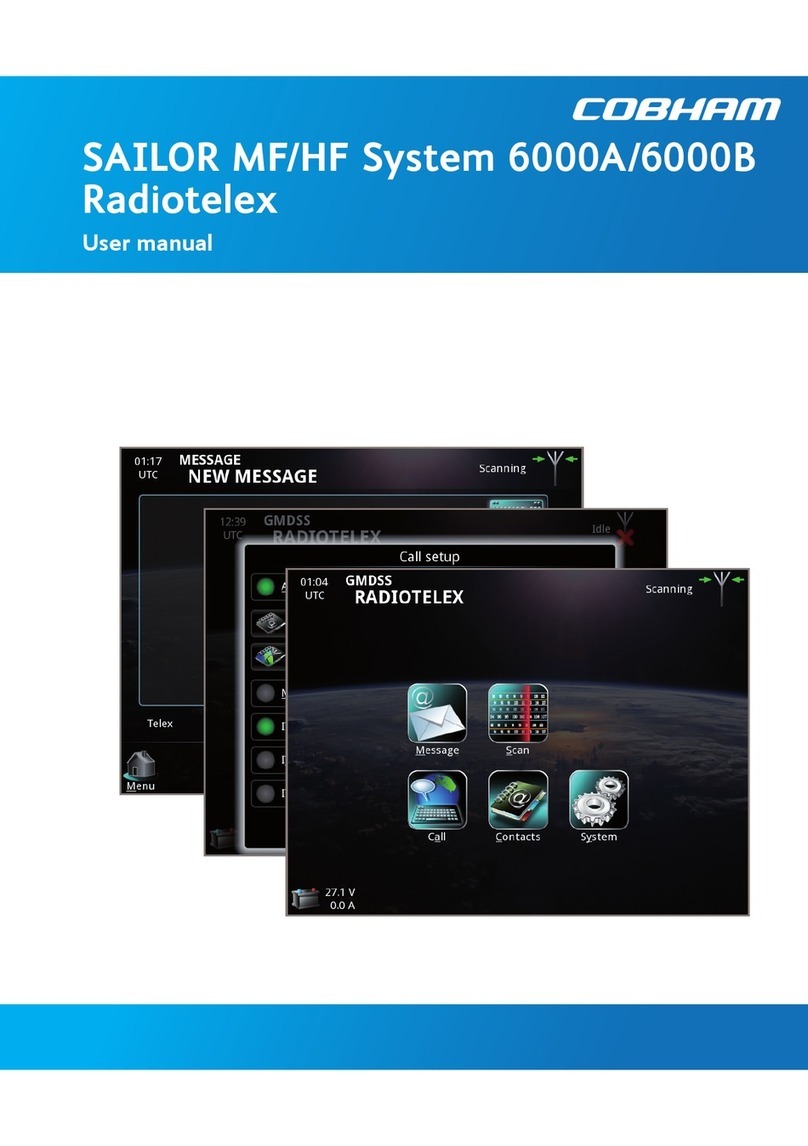
COBHAM
COBHAM SAILOR MF 63 Series User manual
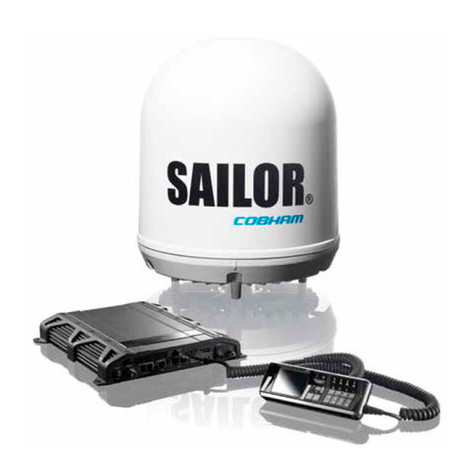
COBHAM
COBHAM SAILOR FleetBroadband Series Installation guide
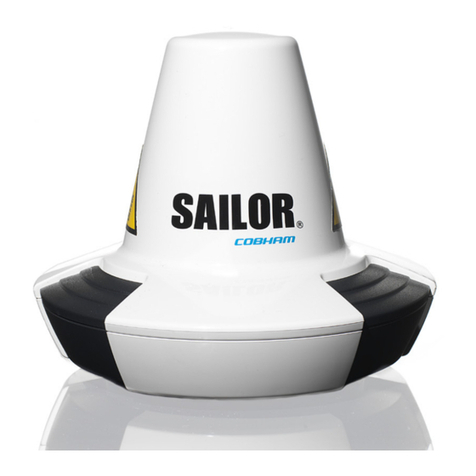
COBHAM
COBHAM SAILOR 6110 mini-C GMDSS User manual
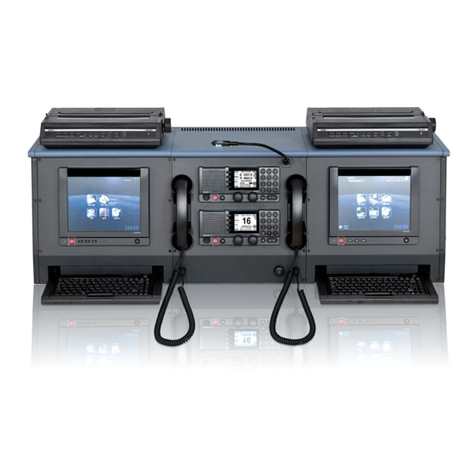
COBHAM
COBHAM SAILOR 6000 User manual
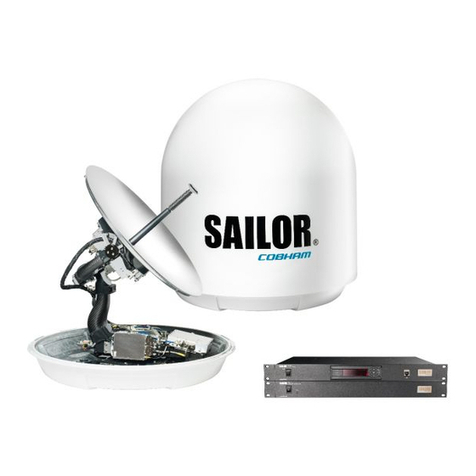
COBHAM
COBHAM SAILOR 100 GX User manual
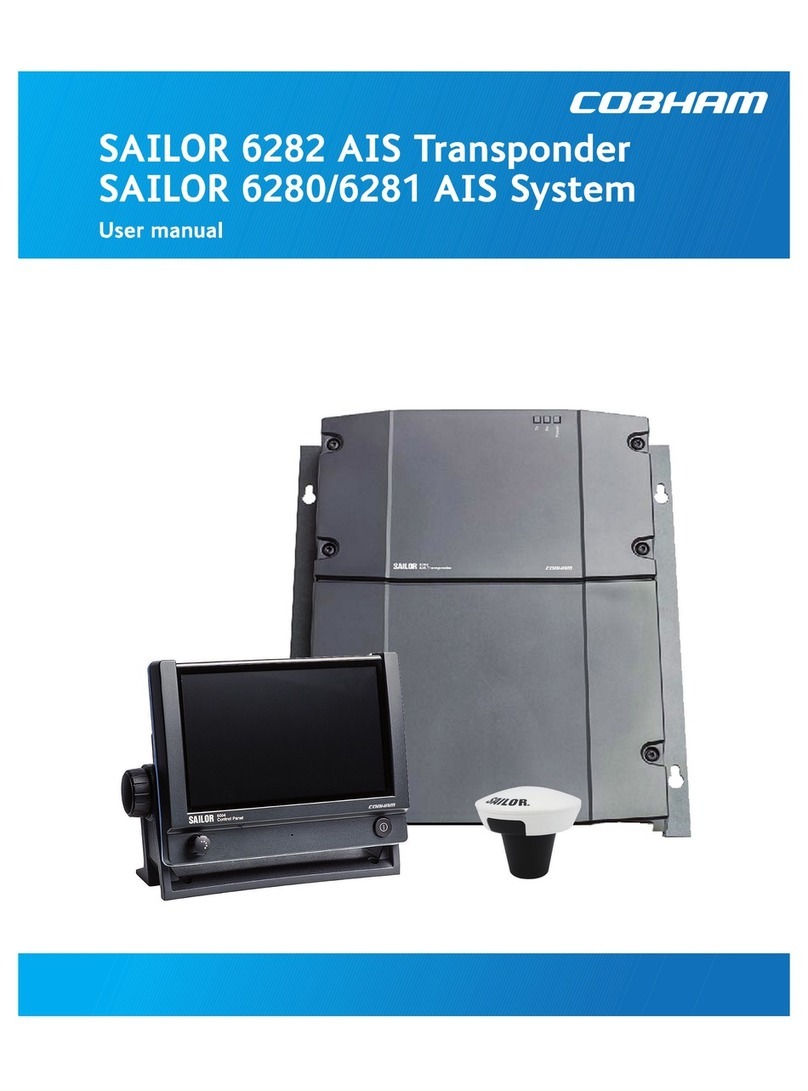
COBHAM
COBHAM SAILOR 6282 User manual
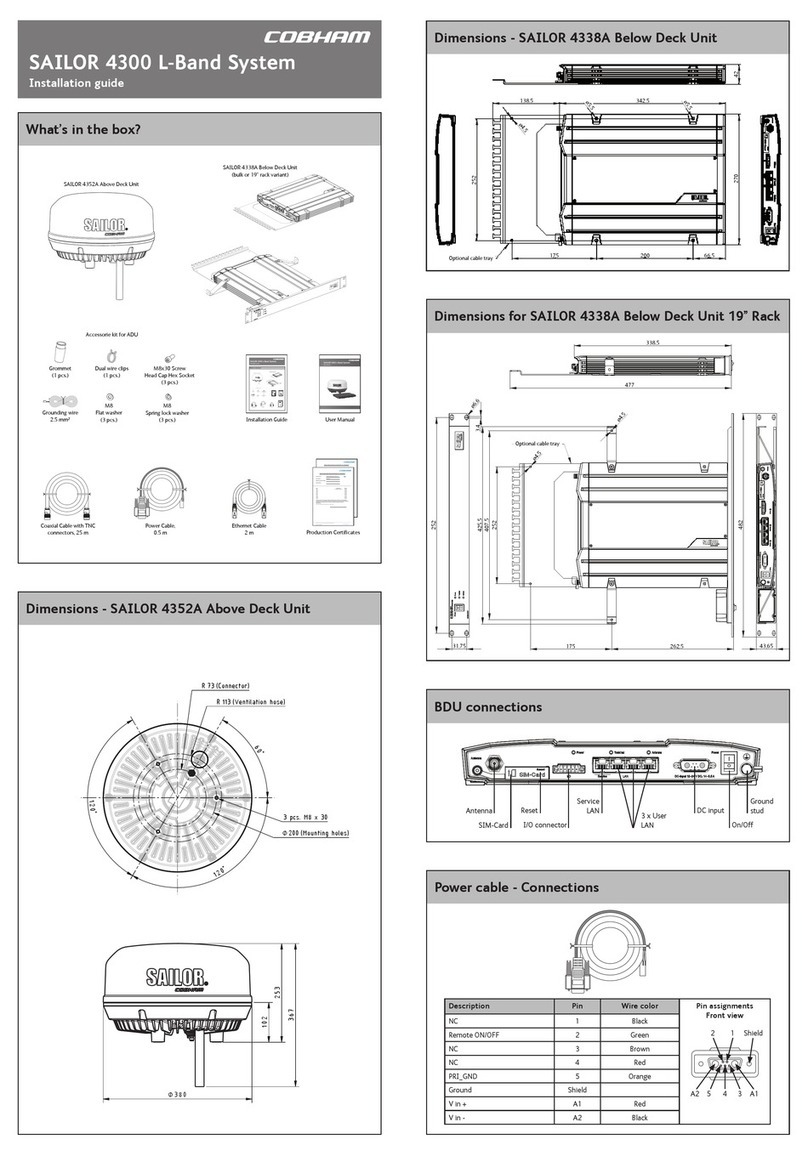
COBHAM
COBHAM SAILOR 4300 L-Band System User manual
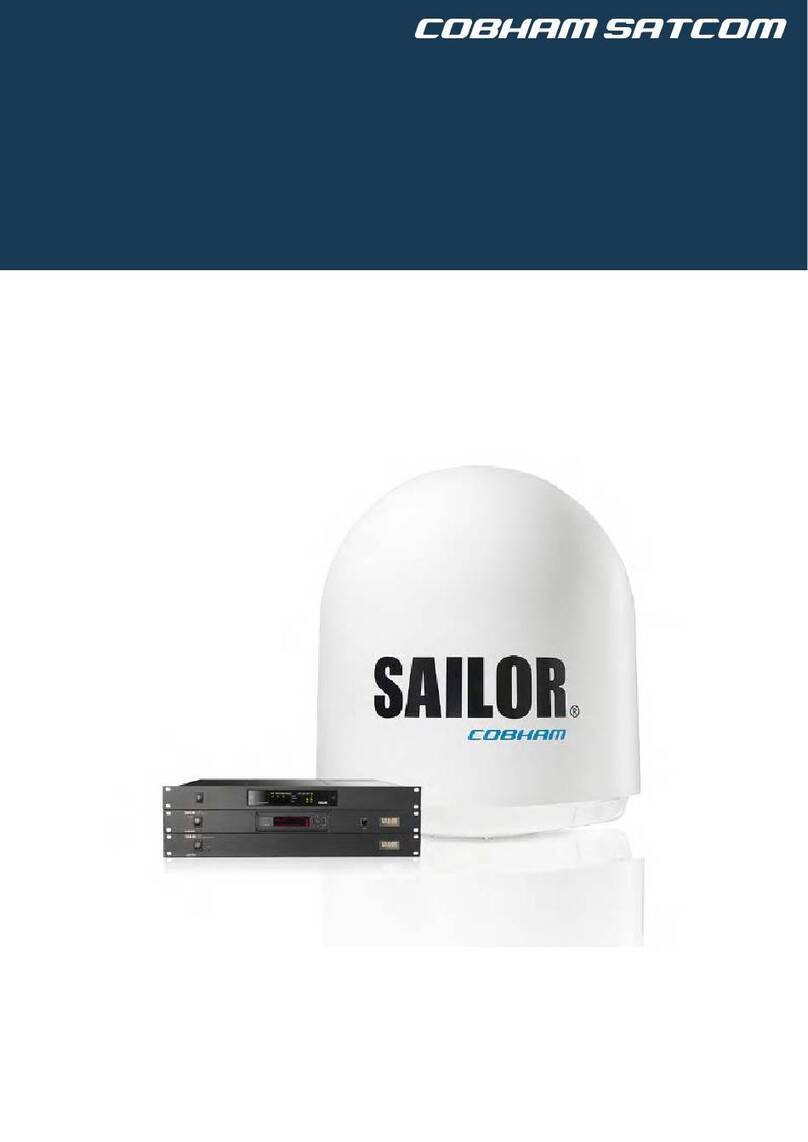
COBHAM
COBHAM SAILOR XTR GX-R2 User manual

COBHAM
COBHAM SAILOR 100 GX User manual
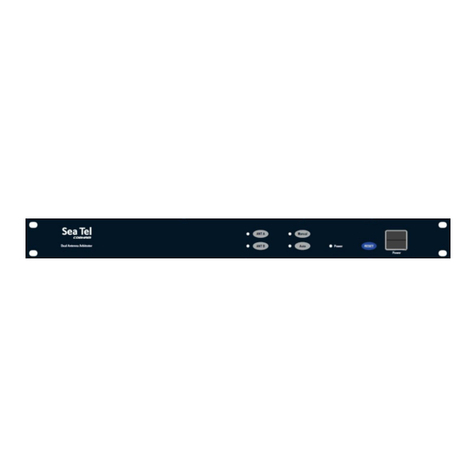
COBHAM
COBHAM Sea Tel Dual Antenna Arbitrator User manual
